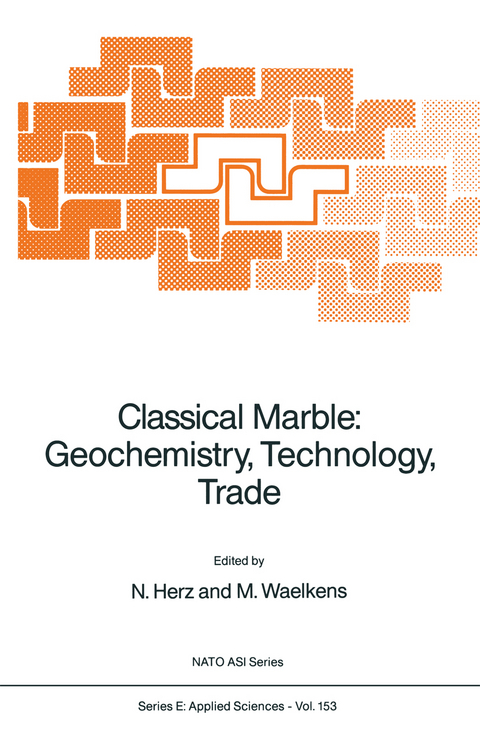
Classical Marble: Geochemistry, Technology, Trade
Springer (Verlag)
978-90-481-8313-5 (ISBN)
Marble in Ancient Greece and Rome: Geology, Quarries, Commerce, Artifacts Marble remains the sine qua non raw material of the an cient Greeks and Romans. Beginning in the Bronze Age sculptu re began in marble and throughout classical times the most im portant statues, reliefs, monuments and inscriptions were made of it. Yet, quarry sources changed in time as preferences for different marbles were influenced by local traditions, the pos sibilities of transport, esthetic tastes, and economics. Marble studies and the identification of the provenance of marble can thus reveal much about Greek and Roman history, trade, esthe tics and technology. Persons in many disciplines are studying various aspects of Greek and Roman marble usage. Geologists and geochemists are working on methods to determine the provenance of marble; ar chaeologists are noting changing patterns of import and use in excavation~ and discovering how improving quarrying techniques and prelimihary dressing of the extracted material influenced the final shape of artifacts; ancient historians are now under standing quarry organization and bureaucracies that controlled marble production and trade; art historians are seeing how phy sical characteristics of the stone affected the techniques and style of sculpture; architects and engineers are interested in quarry technologies and usage in building construction. These specialists drawn from many disciplines rarely have an opportu nity to compare notes and see how each can contribute to the research effort of others.
Introductory Chapters.- J.B. Ward-Perkins and the Marble Committee.- Geology of Greece and Turkey: Potential Marble Source Regions.- Quarries and the Marble Trade in Antiquity.- Quarries and Quarrying Technology.- Extraction of Blocks in Antiquity: Special Methods of Analysis.- Problems of Identification and Interpretation of Tool Marks on Ancient Marbles and Decorative Stones.- Methods of Transporting Blocks in Antiquity.- The Quarries of Mount Taygetos in the Peloponnesos, Greece.- Marmora Lunensia: Quarrying Technology and Archeological Use.- The Geology, Quarrying Technology and Use of Beylerköy Marbles in Western Turkey.- Numidian Marble and Some of its Specialities.- The Roman Quarries of Mons Claudianus, Egypt an Interim Report.- Ancient Granite Quarries on the Bocche di Bonifacio.- Preliminary Dressing of Extracted Material.- The Stages of Workmanship of the Corinthian Capital in Proconnesus and its Export Form.- The Marble Architectural Elements in Export-Form from the ?ile Shipwreck.- Production Patterns of Sarcophagi in Phrygia.- Trade and Archaeological Use of Marble.- The Roman Emperors in the Marble Business: Capitalists, Middlemen or Philanthropists?.- Marble in Cyprus: Classical Times to Middle Ages.- Marble Imports and Local Stone in the Architectural Decoration of Roman Palestine: Marble Trade, Techniques and Artistical Taste.- The Introduction of Polychrome Marbles in Late Republican Rome: The Evidence from Mosaic Pavements with Marble Insertions.- The Marbles Used in the Decoration of Hadrian’s Villa at Tivoli.- From West to East: Evidence for a Shift in the Balance of Trade in White Marbles.- Relationships between Style and Size of Statuary and the Availability of Marble at Cyrene.- Acrolithic or Pseudo-Acrolithic Sculpture of the Mature Classical Greek Period in the Archaeological Museum of the Johns Hopkins University.- Material Limitations and Exotic Materials in the Copying of a Hellenistic Statuary Type.- Marble Veneer from an Urban Archaeological Site in Naples: A Case Study.- Techniques for Determining Provenance: Multivariate Petrographical and Chemical Approaches.- Weathering Characteristics, Age, and Provenance Determinations on Ancient Greek and Roman Marble Artifacts.- A Multi-Method Approach to the Identification of White Marbles Used in Antique Artifacts.- Provenance Characteristics of Cycladic (Paros and Naxos) Marbles — A Multivariate Geological Approach.- Chemical and Petrographical Characterization of Greek Marbles from Pentelikon, Naxos, Paros and Thasos.- Techniques for Determining Provenance: Trace Element Analysis.- Provenance Studies of Greek Marbles by Instrumental Neutron Activation Analysis.- A Computer-Based Pattern Recognition Approach to the Provenance Study of Mediterranean Marbles Through Trace Elements Analysis.- Neutron Activation Analysis: A Powerful Technique in Provenance Studies.- Techniques for Determining Provenance: Stable Isotope Analysis.- The Oxygen and Carbon Isotopic Data Base forClassical Marble.- Geochemistry and Archaeological Geology of the Carrara Marble, Carrara, Italy.- Variations in Stable Isotopic Compositions of Marble: An Assessment of Causes.- Variability in Stable Isotope Analysis: Implications for Joining Fragments.- Statistical Treatment of Stable Isotope Data.- Techniques for Determining Provenance: Xeroradiography, ESR Spectroscopy, X-Ray Powder Diffractometry, and Pore-Size Distribution.- Marble Provenience by Computer-Assisted Analysis of Xeroradiographs.- ESR Spectroscopy and X-Ray Powder Diffractometry for Marble Provenance Determination.- The Interest of Pore-Size Distribution in the Identification of Marbles — Suction Tests.- Provenance Determination Applied to Ancient Artifacts.- Source Analysis of the Raw Materials of Four Classical Marble Sculptures Using Chemical, Microscopic and Isotopic Criteria.- Determination of the Provenance of Marbles Used in Some Ancient Monuments in Rome.- The Arch of Constantine: Marble Samples.- Isotopic Analysis of Seventh-Century B.C. Perirrhanteria.- The Use of Marble Analysis in Collections of Ancient Sculpture: Some Examples from the Ny Carlsberg Glyptotek.- Provenance Investigation of Marbles from Delphi with ESR Spectroscopy.- Marble Samples from the Arch of Constantine in Rome: Results of Electron Spin Resonance and Atomic Emission Analysis.- Decay and Conservation.- The Decay and Conservation of Marbles on Archaeological Monuments.- A Computerised System for the Study and Conservation of Opus Sectile Pavements.
| Erscheint lt. Verlag | 30.12.2010 |
|---|---|
| Reihe/Serie | NATO Science Series E ; 153 |
| Zusatzinfo | XVI, 482 p. |
| Verlagsort | Dordrecht |
| Sprache | englisch |
| Maße | 155 x 235 mm |
| Themenwelt | Geisteswissenschaften ► Archäologie |
| Naturwissenschaften ► Geowissenschaften ► Geologie | |
| Naturwissenschaften ► Geowissenschaften ► Mineralogie / Paläontologie | |
| ISBN-10 | 90-481-8313-8 / 9048183138 |
| ISBN-13 | 978-90-481-8313-5 / 9789048183135 |
| Zustand | Neuware |
| Haben Sie eine Frage zum Produkt? |
aus dem Bereich


